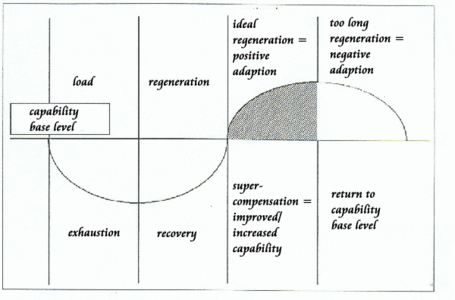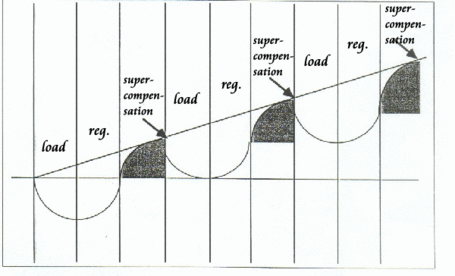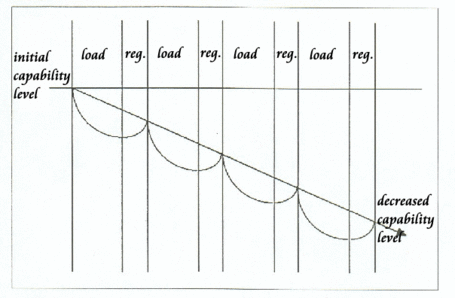Overtraining: A Serious Problem

Stop me if you’ve heard this before: Conditioning month is meant to bring out the best in the high school athlete. It’s a punishing routine, often run twice per day at obscene hours (5 AM morning session, 6 PM evening session) where the men are separated from the boys. The morning session involves running 2 miles to “warm up,” followed by intense 100 meter sprints and other xpxlyometricxx work. Puking is common and is taken as a sign that the workout is hard enough and the coach is doing his job.
In the evening, the players convene for skill work – the soccer players run hours of foot skill drills, exhausted from the morning session, while the football players practice hitting and tackling if they’re not in the weight room performing quarter-squats with 600 pounds on their back. Basketball players are running ladders, suicides, testing their vertical leap, and jumping over xpxlyometricxx hurdles – all the while feeling a burning sensation in their shins but unwilling to speak up to the coach about it. Because after all, no one wants to think that you’re not tough enough, right?
Wrong.
High school coaches are singlehandedly responsible for dogging their athletes and pushing them well past their physical, mental, and psychological limitations. The ones who succeed on these absurd five-day-a-week programs with four or more hours of intense work are the genetic freaks, the ones who are truly the outliers. The ones who fail and suffer injuries are deemed “weak” and not worthy of making the team. The rest plod through it, nursing their “soreness” (in actuality, these are injuries), icing their bodies, and sleeping for hours on end, hoping the pain will go away in time for the season to start. Training is not like a game or sitting in an armchair reading a book – the human body has limits. This ‘eggs against the wall’ training philosophy, where throw enough eggs against a wall and hope that one will end up at the Olympics (but forget about 5,000 that you wrecked), has serious shortcomings. Athletes lose 30 pounds in a month, slash their 40 yard dash time, and increase the weights on their squats that closely resemble a bad leg press rather than a true full squat. Progress was made – the ends justify the means.
Wrong.
High school athletes are often rank novices – they are thoroughly unadapted to stress and can be pushed to their limit every time they train because they have no previous experience! Novices do not get stronger when they train, they get stronger when they recover. Overtraining is when you push an individual past his limitations and do not respect the time it takes to recovery from a workout that disrupts homeostasis. Overloading is when you design a program that disrupts homeostasis – good programs overload, but do not overtrain.
An example of an excellent novice program is that of Mark Rippetoe’s Starting Strength – the novice lifter works every other day, increasing the weight on all of his lifts (Back Squat, Press, Bench Press, Deadlift, Power Clean) every session. This is the linear progression model. The athlete gets one day off between workouts and two on the weekends, though adding a “metabolic conditioning” workout on one of those days is not a terrible idea (as long as there is one day of recovery before the next heavy lifting day).
Training for Novices (aka High School Athletes)
The ideal novice training cycle looks something like this:
- Load phase. This leads to exhaustion and a disruption in homeostasis.
- Recovery phase. This allows the body to recover and rest.
- Supercompensation phase. This is where the body gets stronger and adapts to the stresses placed on it in the Load phase.
The first step is then repeated. However, if the load phase is started too late after supercompensation, then the effects are mitigated and the athlete may return to the base level of fitness. Confused? This excellent graph from Footballdrills.com should help:
More after the jump…
An ideal training cycle can be graphically represented like so:
The straight line is the linear progression of the resistance used while the curves are simply the same graphic from the supercompensation image above. There is a load which must be recovered from, supercompensation occurs, then the athlete trains harder and repeats the cycle until he can no longer do so. When recovery becomes an issue, the athlete should reset the load and attempt to progress in a linear fashion again, and when the athlete hits the wall once more, he should consider intermediate programming.
Intermediate programming is a subject of another post, but to briefly explain it, it is planning your workouts a week in advance rather than simply increasing the load every workout. Intermediate trainees can not recover quickly enough from the load required to disrupt homeostasis to simply add weight over and over again, and so they need to plan a bit further in advance. Most athletes will never progress past intermediate programming and can see gains from this type of programming for years.
Dangers of Overtraining
A sample training / conditioning program from your average high school coach looks something like this:
This is constant training without regard or respect for a recovery cycle, and it leads to a decreased capability level. While strict novices may still see gains overall, they will progress at a much slower rate due to overtraining and stress.
Personal Stories of High School Athletes
One high school student that I previously coached is an excellent athlete, though he could stand to gain 30 or 40 pounds (this is true for nearly every high school athlete). He was an outstanding center fielder, leadoff hitter, and from what I hear, a great shooting guard. He’s in the conditioning program for basketball now, and he recently told me:
Everyday this week I’ve had weightlifting and sprint workouts with less than 16 hrs rest on Friday. Today I did a 20 min recovery jog and then elevated legs for 10 mins and then iced for 3 hrs and when that didn’t work I put on some icyhot and foam rolling… I’m still as sore as I started!
To put it bluntly, this is absolutely unacceptable. This athlete is not “sore.” He is injured. When range of motion is compromised and pain levels do not go away, that’s not normal soreness. That is an injury due to a stupidly designed program by a coach who has no training or education in exercise science who is simply repeating the programs that he suffered through in high school, college, or possibly the professional ranks of sport.
My advice to him was:
You need to not do so much hard ****. I realize this may not be an option since your coaches don’t know how to make a realistic training program, but that’s the truth.
Assuming that you aren’t going to change your coaches’ minds (and you shouldn’t try to, anyway), you should sleep, foam roll, contrast baths (take an ice bath – yes, a FULL ice bath – then drain and immediately take a hot shower; yes this is painful as hell), and eat, eat, EAT.
The last point cannot be overstated. You need to eat 6000 calories per day. No, that number is not a joke. Start eating pizza every day. A lot of it. And McDonalds.
I am serious.
Overtraining Has to Stop
Unfortunately, the solution for overtraining athletes involves using a search engine for more than 10 minutes and maybe taking a class or two on proper exercise science – and we all know that people simply aren’t interested in learning things that are contrary to their rock-solid beliefs.
Train your athletes hard – design a program that makes them sweat, curse, and struggle. But understand that recovery is a necessary part of training, and without it, you are wasting your time and potentially opening up your athletes to injury to salve your ego.
Comment section
Add a Comment
You must be logged in to post a comment.



P90x for Baseball? | Driveline Baseball -
[…] Problem Three: Any exercise program that has you training hard for six days in a row will eventually lead to overtraining, a phenomenon I discussed in an earlier blog post. […]
Recovery From Training: Part One | Driveline Baseball -
[…] written in the past about overtraining and why it’s important to avoid: High school athletes are often rank novices
P90x for Baseball? - Driveline Baseball -
[…] Problem Three: Any exercise program that has you training hard for six days in a row will eventually lead to overtraining, a phenomenon I discussed in an earlier blog post. […]
Recovery From Training: Part One - Driveline Baseball -
[…] written in the past about overtraining and why it’s important to […]